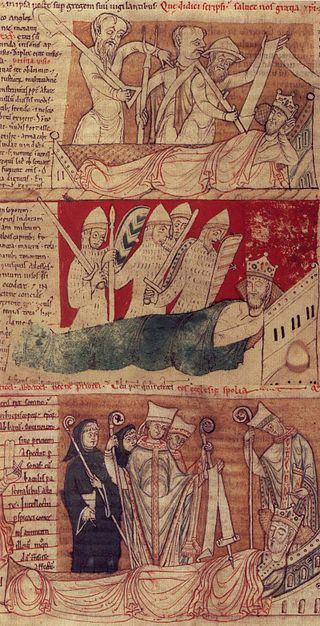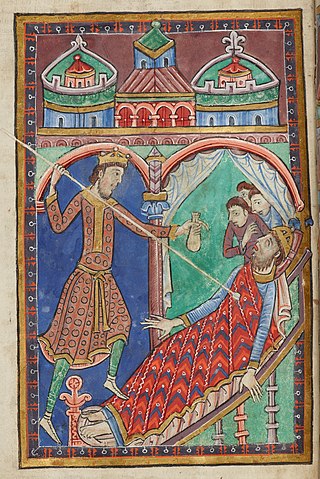Related Research Articles

St Benet's Abbey was a medieval monastery of the Order of Saint Benedict, also known as St Benet's at Holme or Hulme. It was situated at Cow Holm, Horning, on the River Bure within the Broads in Norfolk, England. St Benet is a medieval English version of the name of St Benedict of Nursia, hailed as the founder of western monasticism. At the period of the Dissolution of the Monasteries the abbey's possessions were in effect seized by the crown and assigned to the diocese of Norwich. Though the monastery was supposed to continue as a community, within a few years at least the monks had dispersed. Today there remain only ruins.

Matthew Paris, also known as Matthew of Paris, sometimes confused with the nonexistent Matthew of Westminster, was an English Benedictine monk, chronicler, artist in illuminated manuscripts, and cartographer who was based at St Albans Abbey in Hertfordshire. He authored a number of historical works, many of which he scribed and illuminated himself, typically in drawings partly coloured with watercolour washes, sometimes called "tinted drawings". Some were written in Latin, others in Anglo-Norman or French verse.

Edmund the Martyr was king of East Anglia from about 855 until his death.

The Flores Historiarum is the name of two different Latin chronicles by medieval English historians that were created in the 13th century, associated originally with the Abbey of St Albans.
Spearhafoc was an eleventh-century Anglo-Saxon artist and Benedictine monk, whose artistic talent was apparently the cause of his rapid elevation to Abbot of Abingdon in 1047–48 and Bishop-Elect of London in 1051. After his consecration as bishop was thwarted, he vanished with the gold and jewels he had been given to make into a crown for King Edward the Confessor, and was never seen again. He was also famous for a miracle which impacted his career.
Jocelyn de Brakelond or Jocelin de Brakelonde was an English monk and the author of a chronicle narrating the fortunes of the monastery of Bury St. Edmunds Abbey between 1173 and 1202. He is only known through his own work.

Geoffrey de Runcey (1340s?–1384) was a 14th century chronicler and abbey servant who wrote a valuable, although now-incomplete journal of his travels around medieval East Anglia.
The Chronica Johannis de Oxenedes is a medieval chronicle written in Latin, probably around 1290.
John of Trokelowe was an English chronicler and Benedictine monk of the fourteenth century. He was a monk of St Albans Abbey, and in 1294 was living in the dependent priory of Tynemouth, Northumberland. Once he was thought to be a significant chronicler, on the basis of internal evidence; it is now considered very possible that he was merely the scribe for William Rishanger.

John of Worcester was an English monk and chronicler who worked at Worcester Priory. He is usually held to be the author of the Chronicon ex chronicis.

Saint Robert of Bury was an English boy, allegedly murdered and found in the town of Bury St Edmunds, Suffolk in 1181. His death, which occurred at a time of rising antisemitism, was blamed on local Jews. Though a hagiography of Robert was written, no copies are known, so the story of his life is now unknown beyond the few fragmentary references to it that survive. His cult continued until the English Reformation.

The Liber Eliensis is a 12th-century English chronicle and history, written in Latin. Composed in three books, it was written at Ely Abbey on the island of Ely in the fenlands of eastern Cambridgeshire. Ely Abbey became the cathedral of a newly formed bishopric in 1109. Traditionally the author of the anonymous work has been given as Richard or Thomas, two monks at Ely, one of whom, Richard, has been identified with an official of the monastery, but some historians hold that neither Richard nor Thomas was the author.
Antonia Gransden, English historian and medievalist, was Reader in Medieval History at the University of Nottingham. She was author of works in medieval historiography, including the massive two-volume study Historical Writing in England, covering a thousand years of historical writing from the 6th to the 16th century.
The Historia Ecclesie Abbendonensis or History of the Church of Abingdon was a medieval chronicle written at Abingdon Abbey in England in the 12th century. The Abbey was historically in the county of Berkshire, but since 1974 has been in the county of Oxfordshire.
John of Eversden or Everisden,, was an English chronicler.
The Chronicon Angliae Petriburgense is a 14th-century chronicle written in Medieval Latin at Peterborough Abbey, England, covering events from 604 to 1368, although the original manuscript ends with an entry for 868, and the remainder was added in the 17th century. It survives as part of a composite manuscript volume held at the British Library with the mark Cotton Claudius A.v, in which it appears on folios 2–45. An edition of the Chronicon was published in 1723 by Joseph Sparke, in a collection of English histories by various writers. According to John Allen Giles, in the preface to his own edition published by the Caxton Society in 1845, the Chronicon was attributed by both Simon Patrick and Henry Wharton to John of Caleto, who was an abbot of Peterborough (1250–1262). Giles reported a marginal note in the manuscript making a similar attribution, besides a similar note at the beginning of the manuscript stating that it belonged to Peterborough Abbey. However, Giles observed that this manuscript attribution was "comparatively modern", and regarded the chronicle's author as unknown. In Giles's view, the Chronicon is "extremely valuable both on account of the numerous facts which it contains, and for the [700 years] which it embraces."
William Freney, an Englishman, was a Dominican friar and archbishop of Edessa. His career was divided between England and the Levant. He served as a diplomat and negotiator for both English kings and Popes.
The Brut Chronicle, also known as the Prose Brut, is the collective name of a number of medieval chronicles of the history of England. The original Prose Brut was written in Anglo-Norman; it was subsequently translated into Latin and English.
The Winchcombe Chronicle is a Latin chronicle of the town of Winchcombe from about 1140-1145.

Herman the Archdeacon was a member of the household of Herfast, Bishop of East Anglia, in the 1070s and 1080s. Thereafter, he was a monk of Bury St Edmunds Abbey in Suffolk for the rest of his life.
References
- ↑ Alexander M. Bruce (25 February 2014). Scyld and Scef: Expanding the Analogues. Taylor & Francis. p. 47. ISBN 978-1-317-94421-8.
- ↑ Antonia Gransden (1964). The Chronicle of Bury St Edmunds 1212-1301. Chronica Buriensis 1212-1301. Edited with Introduction, Notes and Translation by Antonia Gransden.
![]() This article incorporates text from a publication now in the public domain : Herbermann, Charles, ed. (1913). "John de Taxster". Catholic Encyclopedia . New York: Robert Appleton Company.
This article incorporates text from a publication now in the public domain : Herbermann, Charles, ed. (1913). "John de Taxster". Catholic Encyclopedia . New York: Robert Appleton Company.